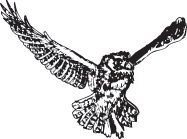

Peregrine Falcon
(Falco peregrinus)
Falcons are the most streamlined raptors, with long pointed wings and long, narrow tails. They are fast agile fliers who feed mostly on other birds they capture in open areas.
The Peregrine Falcon is also known as the duck hawk. Peregrine Falcons are fast, maneuverable birds, who normally fly with rapid, choppy wing beats; they seldom soar or hover. They have a wingspan of 37 to 46 inches (94 to 117 centimeters). Peregrines are a crow-sized falcon.
The head of a Peregrine Falcon has a dark cap and a facial pattern described as a “moustachial stripe.” Their short powerful beaks have a distinct “tomial tooth” that may be used to sever the spinal cord of their prey.
During level flight, a Peregrine can fly about 75 miles per hour. It may reach speeds of more than 200 miles per hour in a dive. This speed makes it the fastest bird on earth. Estimates of home range of Peregrines vary from about 6 to 19 square miles. The original eastern subspecies of the Peregrine Falcon (F. p. anatum) is now extinct.
Peregrines prefer open habitats such as tundra, savanna, seacoasts, high mountains and tall buildings. They bathe and drink frequently, and usually their nest sites are near water. Peregrines are active at all times of the day, including dawn and dusk, and are sometimes nocturnal.
Peregrines have circular nostrils with a central cone which allows them to breath when flying at high speeds. Their third eyelid (nictitating membrane) acts as safety goggles to protect their eyes during dives and when they hit their prey.
As in other falcons, the female is larger than the male: She eats first, dives first and when hunting in pairs, takes larger prey. Peregrines are a playful species; even adults have been seen picking up and dropping and catching plastic objects. Peregrines begin nesting in March and April. Breeding typically does not occur until females are 2 years old and males are 3-5 years.
Courtship includes billing, food transfer, head-bowing, high aerial circling, passing and leading display and talon-grappling.
Peregrines lay their eggs in shallow scrapes on ledges. No nest materials are used. A cliff site maybe used for many years. From two to five eggs are laid, normally at 2-day intervals. Incubation begins before the completion of egg laying and lasts about 32 days.
The young hatch over a two-day period, synchronous hatching, and remain in the nest for 5 to 6 weeks. Peregrines produce one brood per year. Initially, the male does most of the hunting while the female broods and feeds chicks. The female is a very aggressive feeder and the male may drop off food at a certain spot where the female then retrieves it.
Peregrines are aerial and perch hunters. They stoop or fly fast and low after a wide variety of birds, such as doves and pigeons, shorebirds, waterfowl and songbirds. Peregrines also feed on bats and large flying insects, captured in flight. Mated Peregrines may hunt cooperatively, one falcon flushing prey for the other to capture. The capture is usually made as an “underside grab” in which the falcon swings upward and grabs the prey from underneath.
Peregrine means wanderer, peregrines nesting in the far north, such as in Alaska and Canada, migrate as much as 6,000 miles each fall and spring. Most migration seems to take place along the Atlantic and Pacific coasts. They usually migrate singly and often continuously and at fairly low altitudes. More southern Peregrine populations migrate only short distances, or not at all. Northern populations “leapfrog” over their southern relatives, often migrating into the tropics to as far south as Tierra del Fuego.
The North American Peregrine Falcon population started to seriously decline in the 1940s as a result of the use of the insecticide DDT, shooting, egg-collecting and other disturbances. DDT was passed up the food chain to the falcons being concentrated more and more as it moved up each step in the food chain. DDT and other poisons such as PCBs caused the Peregrine females to lay eggs with very thin eggshells. When the female falcons tried to incubate the eggs the shells broke.
By 1975 there were only 39 nesting pairs of Peregrines in the lower 48 states, and the Eastern Peregrine Falcon (F. p. anatum) were extinct east of the Mississippi River. The Peregrine Falcon was declared an endangered species, and a captive breeding and release program was established to ensure the bird’s survival. Six thousand young peregrines were released into the wild in less than 20 years. The “Eastern” Peregrine Falcon reintroduced to the New England states, New York State and the Appalachian Mountains was produced by crossing three other subspecies of Peregrine Falcons.
Today, the Peregrine Falcon population is doing much better. Over 1,500 nesting pairs exist in the United States. Because of their success, the Peregrine Falcon was removed from the endangered species list in 1999. The high populations of Rock Doves in the cities provide them a year-around food supply. Also the city nesting areas have low populations of Great Horned Owls who are natural enemies to adult and nesting Peregrines. Some levels of pesticides will be present in Peregrines for decades to come as the pesticides still exist in their food chains.
Other threats to Peregrines include illegal shooting, electrocution from utility wires and injuries from colliding with utility wires, cars, trains and glass windows. The North American region with the most impressive population of Peregrine Falcons today is the Grand Canyon of the Colorado River in Arizona.